 Animals
Animals  Animals
Animals  Facts
Facts Ten Unexpectedly Fascinating Facts About Rain
 Crime
Crime 10 Dark Details of Australia’s Gruesome Unsolved Wanda Murders
 Humans
Humans 10 Unsung Figures Behind Some of History’s Most Famous Journeys
 Animals
Animals 10 Species That Refused to Go Extinct
 Weird Stuff
Weird Stuff 10 Weird Things People Used to Do at New Year’s
 Our World
Our World 10 Archaeological Discoveries of 2025 That Refined History
 Weird Stuff
Weird Stuff 10 Fascinating Facts You Might Not Know About Snow
 Miscellaneous
Miscellaneous Top 10 Things Crypto Was Supposed to Change & What Actually Did
 History
History 10 Huge Historical Events That Happened on Christmas Eve
 Animals
Animals 10 Strange Times When Species Evolved Backward
 Facts
Facts Ten Unexpectedly Fascinating Facts About Rain
 Crime
Crime 10 Dark Details of Australia’s Gruesome Unsolved Wanda Murders
Who's Behind Listverse?

Jamie Frater
Head Editor
Jamie founded Listverse due to an insatiable desire to share fascinating, obscure, and bizarre facts. He has been a guest speaker on numerous national radio and television stations and is a five time published author.
More About Us Humans
Humans 10 Unsung Figures Behind Some of History’s Most Famous Journeys
 Animals
Animals 10 Species That Refused to Go Extinct
 Weird Stuff
Weird Stuff 10 Weird Things People Used to Do at New Year’s
 Our World
Our World 10 Archaeological Discoveries of 2025 That Refined History
 Weird Stuff
Weird Stuff 10 Fascinating Facts You Might Not Know About Snow
 Miscellaneous
Miscellaneous Top 10 Things Crypto Was Supposed to Change & What Actually Did
 History
History 10 Huge Historical Events That Happened on Christmas Eve
10 Creepy Ancient Wooden Idols
The roots of religion run deep in humanity. It is almost impossible to reconstruct the most ancient religious practices, but we can see hints of them in strange cave paintings and bone carvings. We cannot know what these objects truly meant to people thousands of years ago, and much that our ancestors made as an expression of faith has been lost to the passage of time.
Wood was one of the most easily worked materials, and so many idols must have been made from it, but wood also rots. It takes a very specific set of circumstances for wooden objects of any real age to survive, but sometimes we do find them. And they can be deeply unsettling.
Here are ten of the strangest and creepiest wooden idols ever discovered.
Related: 10 Glittering Golden Artifacts from the Ancient World
10 Dagenham Idol
When digging in the muddy ground around the Thames, you never know what you will find because it has been inhabited for so long. You might discover ancient megafauna, Roman pottery, or a modern rubbish dump. In 1922, a sewer was being dug in Dagenham just north of the river when workers pulled up a piece of wood roughly carved to resemble a human.
Now known as the Dagenham Idol, this 18-inch (46cm) humanoid is made of pine wood and has been carbon-dated to around 2250 BC. This was a moment of transition in British history as the Stone Age gave way to the Bronze Age. Was the Dagenham Idol simply a statue of a human, or was it a religious item?
Several clues point to a religious usage. There is an ambiguity about the gender of the subject as there is a hole in the crotch. Was it meant to be female, or was a detachable phallus there? If so, the size of the hole makes it clear the statue was well-endowed. Why was the left eye of the statue damaged? Some have linked the wounded eye to the much later legends of Odin being blinded in one eye.[1]
9 Broddenbjerg Idol
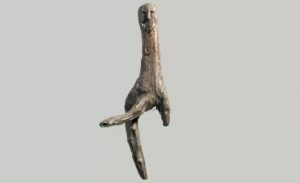
In 1880, a person was out in the bog near Broddenbjerg in Denmark when they stumbled on a piece of wood with a very disconcerting shape. At some point in the past, a person had found an oak branch of a very particular form and decided to shape it into an idol. An idol with a very large penis—a type of statue known as ithyphallic.
The Broddenbjerg Idol stands around 35.5 inches (90cm) tall, while the protruding phallus stands nearly 12 inches (30cm) long, which most men would admit is somewhat disproportionate. It stands on two legs, which could have been pushed into the ground. Oddly, the top half is simply a long body terminating in a face with a pointed beard. The idol was discovered next to a pile of stones, which may have formed an altar. The penis was polished with resin, likely making it glisten. This strange carving was made around 530 BC.[2]
8 Braak Bog Figures
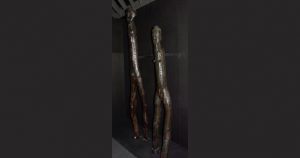
Finding one wooden figure from antiquity is rare, but finding two in the same location is a major discovery. In 1947, two statues carved from oak were excavated in a bog in Braak in northern Germany, and they seem to have formed a pair—one is male, and the other is female. Both of them would have been imposing sights as they are well over 6.5 feet (2 meters) tall.
Both were carved with sockets where arms were once attached, and their faces were rudimentary, but they had distinctive hairstyles. Perhaps the most striking details are the sexual characteristics that have been picked out. The female figure’s genitalia are large and on display, while the male’s penis was either lost in time or hacked off in the past. They date from around the 3rd century BC.
Historians differ on what they could represent. Some consider them to be the high lord and lady gods of an ancient pantheon. Others think they might be linked to ancestor worship. The later Norse religion told tales of how the first man and woman, Ask and Embla, were carved from wood by the gods.[3]
7 Ballachulish Figure
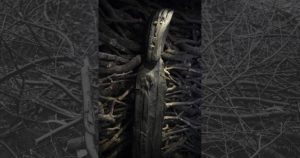
In 1880, workers digging a trench for the construction of a wall in Ballachulish, Scotland, made the discovery of a lifetime when they uncovered the almost life-size wooden statue of a woman. Antiquarians at the time were very excited and suggested it might have been brought to Scotland by Norse raiders in the 9th century. Later dating would find that it was actually carved in around 600 BC.
The Ballachulish figure has a haunting stare created by two pebbles, which have been inserted into the face for eyes, and the mouth is slightly opened. The figure was definitely female due to the presence of female genitalia, but the chest was flat with no hint of breasts. The figure was positioned to look over a treacherous stretch of water and may have acted as a protective charm.
Many of the figure’s details can only be picked out on photos taken immediately after its discovery. Although wet conditions can preserve wood for thousands of years, conserving them out of the water is difficult. Many suggested that the statue be kept wet, but no vessels were large enough to house it, so it was allowed to dry out. The dried wood broke at the knees, and almost half of the face fell off.[4]
6 Wittemoor Figures
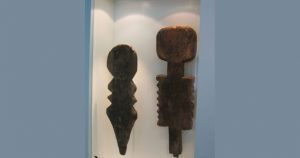
Bogs, with their damp conditions and low oxygen levels, are excellent at preserving timber, but they are also a nightmare to cross. Some of the most exciting archaeological finds in bogs show how our ancestors navigated them. Raised wooden trackways have been discovered in many locations that were erected in antiquity to help people find their way across dangerous ground. At Wittemoor in Germany such a track was discovered, along with six abstract figurines.
The figures recovered were carved from oak boards and stand around 3.3 feet (1 meter) tall. They have clearly outlined heads but no features, and their bodies are curiously shaped. Some have been interpreted as female due to a visible vulva, and some are male, but the distinction is unclear.
Exactly what these figures were is open to interpretation. They might have been spirits of the bog or carved charms to ensure that people used the walkway under the safety of their protection. Perhaps they were simply distinctive markers to guide people as they walked. We may never know what people were thinking when they were set up in the 2nd century BC.[5]
5 Gortnacrannagh Idol
Many religious archaeological sites are found near water. Our ancestors perhaps considered rivers, ponds, and springs as places where offerings to the gods were particularly powerful. Worshippers would deposit a variety of items in the water and many wooden idols have been found beside such ritual locations.
At Gortnacrannagh, Ireland, archaeologists have uncovered a rich site littered with animal bones, some of them purposefully buried in sacred ways, and other artifacts. One of the most spectacular finds was a tall wooden idol with a head and deep gouges decorating the chest. Dating from the 3rd to the 5th century AD, this idol comes from the last days of pagan worship in Ireland before the conversion to Christianity.
The idol was found buried face down. This may represent it being ritually returned to the earth as the site was being abandoned as sites sometimes were, or it may have been done as Christianity displaced older forms of worship.[6]
4 Roman Figure
Building a high-speed railway line across England proved to be a blessing for archaeologists. Before any construction work, the entire route had to be checked to ensure it did not destroy any priceless bits of Britain’s past. In 2021, an exploration of a ditch revealed an incredibly rare Roman-era wooden statue.
The Romans may be famous for their exquisite marble sculptures but their world was also full of wooden artworks that have long since disappeared. This figure of a man is instantly recognizable as Roman because of the style of clothes it is wearing and even the hairstyle. Archaeologists have tentatively dated it to around AD 60, just after Britain had been brought into the Roman world.
Was this an image of a god? Perhaps it was a votive offering. The Romans would make models of body parts and leave them at shrines as either thanks for divine healing or in hopes of one.[7]
3 Ralaghan Idol
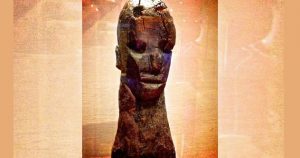
A bog being dug in Ralaghan, Ireland, in 1930 turned up a strange statue. It was found buried several feet deep and placed with its face down into the earth. In Ireland, this is usually the position in which sacrificed humans were placed in bogs.
The statue is carved from yew wood, which is toxic and has long been associated with folklore in Ireland and Britain. The face on the idol was strongly modeled, and as with other such statues, there is a hint of damage to the left eye, which might have had religious significance. Like several of these figures, the sex of the subject is ambiguous because there is only a hole carved at the pelvis. If it once had a phallus in it then it is possible that it would be removed at times depending on whether the statue was being used in a female or male act. The Ralaghan Idol dates to around 1000 BC, offering potential insights into the minds of people who have left few traces.[8]
2 Roos Carr Figures
When a single wooden statue is found with parts missing, it can be hard to attempt to reconstruct them. In 1836, while digging a ditch in Roos Carr, England, a group of laborers revealed a cache of eight wooden figures and a small wooden boat into which they could be inserted. It was a treasure trove for antiquarians, though one escaped the clutches of historians and seems to have been given to a young girl to play with as a dolly.
The Roos Carr figures are made from yew wood and have white pebbles made from quartzite inserted into their faces as eyes. The figures had some small pieces of wood found with them, and the Victorian curators were unsure what to do. At first, they assumed the extra wood were arms—but it has since been proved that they were detachable penises. Finally, archaeologists could show that at least some of these idols did have phalluses, which could be stuck into the holes carved in their pelvises.
Who these well-endowed figures were remains mysterious. We may never know why they were buried or placed in a body of water over 2,500 years ago.[9]
1 Shigir Idol
The oldest wooden sculpture known belongs to a similar tradition of idol carving that we have already seen but is dramatically older than anything else on this list, and also larger. Found in Shigir, Russia, in a peat bog, it dates from 12,000 years ago. When this idol was set up there, woolly mammoths were still roaming the world. The Shigir Idol currently stands at nearly 10 feet (3 meters) tall but might once have been as much as 16 feet (5 meters) tall.
The idol was carved from a long section of larch wood, and its body is flat and rectangular. The surface of the body is marked with geometric designs. Some of them on the chest may represent ribs. Different carved marks could represent genitals and buttocks.
It is the face, however, that draws the most attention. It is haunting to look at, with its blank spaces for eyes and a small circular hole for a mouth. What did the Shigir Idol mean to the people who set it up? When people looked up into that face, their lives were almost unfathomably different.[10]








